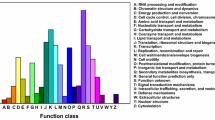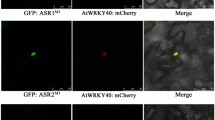Abstract
Key message
RsMYB1, a MYB TF of red radish origin, was characterized as a positive regulator to transcriptionally activate the anthocyanin biosynthetic machinery by itself in Arabidopsis and tobacco plants.
Abstract
Anthocyanins, providing the bright red-orange to blue-violet colors, are flavonoid-derived pigments with strong antioxidant activity that have benefits for human health. We isolated RsMYB1, which encodes an R2R3-MYB transcription factor (TF), from red radish plants (Raphanus sativus L.) that accumulate high levels of anthocyanins. RsMYB1 shows higher expression in red radish than in common white radish, in both leaves and roots, at different growth stages. Consistent with RsMYB1 function as an anthocyanin-promoting TF, red radishes showed higher expression of all six anthocyanin biosynthetic and two anthocyanin regulatory genes. Transient expression of RsMYB1 in tobacco showed that RsMYB1 is a positive regulator of anthocyanin production with better efficiency than the basic helix-loop-helix (bHLH) TF gene B-Peru. Also, the synergistic effect of RsMYB1 with B-Peru was larger than the effect of the MYB TF gene mPAP1D with B-peru. Arabidopsis plants stably expressing RsMYB1 produced red pigmentation throughout the plant, accompanied by up-regulation of the six structural and two regulatory genes for anthocyanin production. This broad transcriptional activation of anthocyanin biosynthetic machinery in Arabidopsis included up-regulation of TRANSPARENT TESTA8, which encodes a bHLH TF. These results suggest that overexpression of RsMYB1 promotes anthocyanin production by triggering the expression of endogenous bHLH genes as potential binding partners for RsMYB1. In addition, RsMYB1-overexpressing Arabidopsis plants had a higher antioxidant capacity than did non-transgenic control plants. Taken together, RsMYB1 is an actively positive regulator for anthocyanins biosynthesis in radish plants and it might be one of the best targets for anthocyanin production by single gene manipulation being applicable in diverse plant species.








Similar content being viewed by others
Abbreviations
- 4CL:
-
4-coumarate-CoA ligase
- bHLH:
-
basic helix-loop-helix
- ANS:
-
anthocyanidin synthase
- CHI:
-
chalcone isomerase
- CHS:
-
chalcone synthase
- DFR:
-
dihydroflavonol 4-reductase
- F3H:
-
flavanone 3-hydroxylase
- F3′H:
-
flavonoid 3′-hydroxylase
- PAL:
-
phenylalanine ammonia lyase
- qRT-PCR:
-
quantitative real time polymerase chain reaction
- TF:
-
transcription factor
- TT2:
-
TRANSPARENT TESTA2
- TT8:
-
TRANSPARENT TESTA8
- TTG1:
-
TRANSPARENT TESTA GLABRA1
References
Aharoni A, De Vos CHR, Wein M, Sun Z, Greco R, Kroon A, Mol JNM, O’Connell AP (2001) The strawberry FaMYB1 transcription factor suppresses anthocyanin and flavonol accumulation in transgenic tobacco. Plant J 28:319–332
Akihisa T, Tokuda H, Ukiya M, Iizuka M, Schneider S, Ogasawara K, Mukainaka T, Iwatsuki K, Suzuki T, Nishino H (2003) Chalcones, coumarins, and flavanones from the exudate of Angelica keiskei and their chemopreventive effects. Cancer Lett 25:133–137
Blažević I, Mastelić J (2009) Glucosinolate degradation products and other bound and free volatiles in the leaves and roots of radish (Raphanus sativus L.). Food Chem 113:96–102
Borevitz JO, Xia Y, Blount J, Dixon RA, Lamb C (2000) Activation tagging identifies a conserved MYB regulator of phenylpropanoid biosynthesis. Plant Cell 12:2383–2394
Bovy A, de Vos R, Kemper M, Schijlen E, Almenar Pertejo M, Muir S, Collins G, Robinson S, Verhoeyen M, Hughes S, Santos-Buelga C, van Tuinen A (2002) High-flavonol tomatoes resulting from the heterologous expression of the maize transcription factor genes LC and C1. Plant Cell 14:2509–2526
Butelli E, Titta L, Giorgio M, Mock HP, Matros A, Peterek S, Schijlen EG, Hall RD, Bovy AG, Luo J, Martin C (2008) Enrichment of tomato fruit with health-promoting anthocyanins by expression of select transcription factors. Nat Biotechnol 26:1301–1308
Chiu LW, Zhou X, Burke S, Wu X, Prior RL, Li L (2010) The purple cauliflower arises from activation of a MYB transcription factor. Plant Physiol 154:1470–1480
Clough SJ, Bent AF (1998) Floral dip: a simplified method for Agrobacterium-mediated transformation of Arabidopsis thaliana. Plant J 16:735–743
Dubos C, Le Gourrierec J, Baudry A, Huep G, Lanet E, Debeaujon I, Routaboul J-M, Alboresi A, Weisshaar B, Lepiniec L (2008) MYBL2 is a new regulator of flavonoid biosynthesis in Arabidopsis thaliana. Plant J 55:940–953
Espley RV, Hellens RP, Putterill J, Stevenson DE, Kutty-Amma S, Allan AC (2007) Red colouration in apple fruit is due to the activity of the MYB transcription factor, MdMYB10. Plant J 49:414–427
Grotewold E (2006) The genetics and biochemistry of floral pigments. Annu Rev Plant Biol 57:761–780
Hichri I, Barrieu F, Bogs J, Kappel C, Delrot S, Lauvergeat V (2011) Recent advances in the transcriptional regulation of the flavonoid biosynthetic pathway. J Exp Bot 62:2465–2483
Huang W, Sun W, Lv H, Luo M, Zeng S, Pattanaik S, Yuan L, Wang Y (2013a) A R2R3-MYB transcription factor from Epimedium sagittatum regulates the flavonoid biosynthetic pathway. PLoS One 8:e70778
Huang YJ, Song S, Allan AC, Liu XF, Yin XR, Xu CJ, Chen KS (2013b) Differential activation of anthocyanin biosynthesis in Arabidopsis and tobacco over-expressing an R2R3 MYB from Chinese bayberry. Plant Cell Tissue Organ Cult 113:491–499
Kim GR, Jung ES, Lee S, Lim SH, Ha SH, Lee CH (2014) Combined mass spectrometry-based metabolite profiling of different pigmented rice (Oryza sativa L.) seeds and correlation with antioxidant activities. Molecules 19:15673–15686
Koes R, Verweij W, Quattrocchio F (2005) Flavonoids: a colorful model for the regulation and evolution of biochemical pathways. Trends Plant Sci 10:236–242
Lai B, Li XJ, Hu B, Qin YH, Huang XM, Wang HC, Hu GB (2014) LcMYB1 is a key determinant of differential anthocyanin accumulation among genotypes, tissues, developmental phases and ABA and light stimuli in Litchi chinensis. PLoS One 9:e86293
Lepiniec L, Debeaujon I, Routaboul JM, Baudry A, Pourcel L, Nesi N, Caboche M (2006) Genetics and biochemistry of seed flavonoids. Annu Rev Plant Biol 57:405–430
Lim SH, Ha SH (2013) Marker development for identification of rice seed coat color. Plant Biotechnol Rep 7:391–398
Lim SH, Kim DH, Kim JK, Lee JY, Kim YM, Sohn SH, Kim DH, Ha SH (2013) Petal-specific activity of the promoter of an anthocyanin synthase gene of tobacco (Nicotiana tabacum L.). Plant Cell Tiss Organ Cult 114:373–383
Lim SH, Sohn SH, Kim DH, Kim JK, Lee JY, Kim YM, Ha SH (2012) Use of an anthocyanin production phenotype as a visible selection marker system in transgenic tobacco plant. Plant Biotechnol Rep 6:203–211
Lin-Wang K, Bolitho K, Grafton K, Kortstee A, Karunairetnam A, McGhie TK, Espley RV, Hellens RP, Allan AC (2010) An R2R3 MYB transcription factor associated with regulation of the anthocyanin biosynthetic pathway in Rosaceae. BMC Plant Biol 10:50
Lloyd AM, Walbot V, Davis RW (1992) Arabidopsis and Nicotiana anthocyanin production activated by maize regulators R and C1. Science 258:1773–1775
Matsui K, Umemura Y, Ohme-Takagi M (2008) AtMYBL2, a protein with a single MYB domain, acts as a negative regulator of anthocyanin biosynthesis in Arabidopsis. Plant J 55:954–967
Park NI, Xu H, Li X, Jang IH, Park S, Ahn GH, Lim YP, Kim SJ, Park SU (2011) Anthocyanin accumulation and expression of anthocyanin biosynthetic genes in radish (Raphanus sativus). J Agri Food Chem 59:6034–6039
Qiu J, Sun S, Luo S, Zhang J, Xiao X, Zhang L, Wang F, Liu S (2014) Arabidopsis AtPAP1 transcription factor induces anthocyanin production in transgenic Taraxacum brevicorniculatum. Plant Cell Rep 33:669–680
Shin J, Park E, Choi G (2007) PIF3 regulates anthocyanin biosynthesis in an HY5-dependent manner with both factors directly binding anthocyanin biosynthetic gene promoters in Arabidopsis. Plant J 49:981–994
Vimolmangkang S, Han Y, Wei G, Korban SS (2015) An apple MYB transcription factor, MdMYB3, is involved in regulation of anthocyanin biosynthesis and flower development. BMC Plant Biol 13:176
Yamagishi M, Shimoyamada Y, Nakatsuka T, Masuda K (2010) Two R2R3-MYB genes, homologs of petunia AN2, regulate anthocyanin biosynthesis in flower tepals, tepal spots and leaves of Asiatic hybrid lily. Plant Cell Physiol 51:463–474
Acknowledgments
This work was supported by a fund from the National Academy of Agricultural Science (PJ01002701) and a grant from the Next-Generation BioGreen 21 Program (PJ01109402), Rural Development Administration, Republic of Korea.
Author information
Authors and Affiliations
Corresponding authors
Ethics declarations
Conflict of interest
The authors declare that they have no conflict of interest.
Additional information
Communicated by Y.-I. Park.
Electronic supplementary material
Below is the link to the electronic supplementary material.
299_2015_1909_MOESM1_ESM.tif
Supplementary Figure legends, Figure 1. The genomic structure of radish RsMYB1 and multiple alignment of the amino acid sequences among R2R3-MYBs. (A) Schematic representation of the structure of RsMYB1. The black boxes represent exons and solid lines represent introns. (B) Multiple sequence alignment of the R2R3-MYB transcription factors related to anthocyanin production that were used in the neighbor-joining phylogenetic tree (Fig. 1). Arrows indicate specific residues that contribute to a motif implicated in the interaction with the bHLH co-factor in Arabidopsis. The red box and black box represent the conserved ANDV motif and the C-terminal-conserved KPRPR[S/T]F motif of anthocyanin-promoting MYBs, respectively. Numbers on the right denote the number of amino acid residues. Residues identical for all the sequences in a given position are in white text on a black background and residues identical for at least over 80 % in a given position are presented in white text on a dark grey background and residues identical ranged from 60 to 80 % in given position are presented in white text on a light gray background. The following sequences were included in the analysis: AmROSEA1 (ABB83826) and AmVENOSA (ABB83828) in Antirrhinum majus, AtPAP1 (NP_176057) and AtPAP2 (NP_176813) in Arabidopsis, BoMYB2 (ADP76650) in Brassica oleracea, GhMYB10 (CAD87010) in Gerbera hybrida, LeANT1 (AAQ55181) in Lycopersicon esculentum, MdMYB10 (ABB84753) in Malus × domestica, OsC1 (CAA75509) in Oryza sativa, PhAN2 (AAF66727) in Petunia × hybrida, RsMYB1 (KR706195) in Raphanus sativus and ZmPl (AAA19821) and ZmC1 (P10290) in Zea mays (TIFF 1926 kb)
Rights and permissions
About this article
Cite this article
Lim, SH., Song, JH., Kim, DH. et al. Activation of anthocyanin biosynthesis by expression of the radish R2R3-MYB transcription factor gene RsMYB1 . Plant Cell Rep 35, 641–653 (2016). https://doi.org/10.1007/s00299-015-1909-3
Received:
Revised:
Accepted:
Published:
Issue Date:
DOI: https://doi.org/10.1007/s00299-015-1909-3




